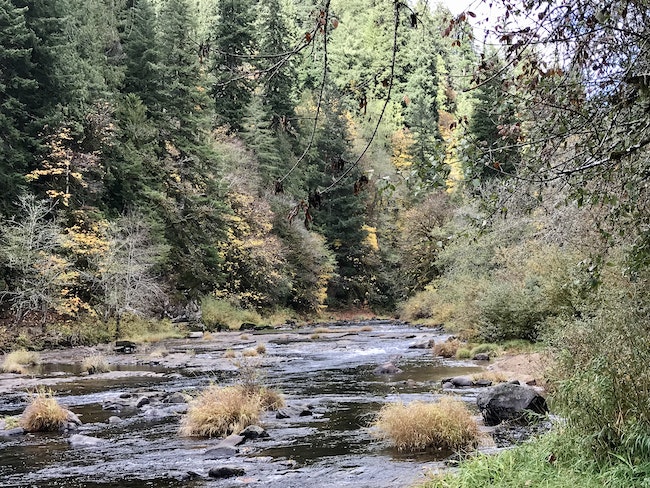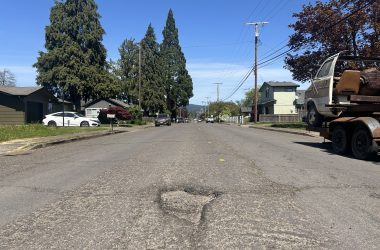 FRANK ARMENDARIZ/THE CHRONICLEFall has come to Lane County and so has fall fishing. The hot weather for now is a memory and wild trout in the lower McKenzie and Willamette rivers are active again.
FRANK ARMENDARIZ/THE CHRONICLEFall has come to Lane County and so has fall fishing. The hot weather for now is a memory and wild trout in the lower McKenzie and Willamette rivers are active again.
If you look around there is little doubt that with the certainty of the sunrise, winter will soon be here. Rain is in the forecast for this weekend and the comfortable 60-degree daytime temperatures that we have enjoyed will retreat to a more seasonal range in the 50s. And across our region for the first time since late last winter, low temperatures in the 30s are also in the forecast. Nothing out of sorts here; typical fall pattern and weather.
At the top of the report, it’s hard to overlook that one of our counties, in fact one of our state’s premier fishing resources, was badly damaged by fire this season. Sadly, with McKenzie so compromised this fall, it clears the table of a lot of nearby opportunities for local anglers.
Traveling beyond the hamlet of Leaburg leads you into an ongoing disaster recovery zone where an army of utility and road construction workers are feverishly toiling to return power, communication lines and restore a dependable transportation corridor before winter sets in.
I would discourage everyone from traveling up the McKenzie River Highway past Leaburg at this time and that folks resist finding themselves in the fray of rebuilding activities. Theft has been an ongoing issue in the fire zone. People wandering around the burn are very likely to encounter a patrol officer or a neighborhood watch group patrolling what was formerly their neighborhood, with their eyes open for thieves.
But the good news is that lower portions of the McKenzie and the wild trout section of the Willamette River north to Harrisburg are good, productive river segments in the fall, where river-boating anglers will find plenty of wild trout and possibly a late-summer steelhead or two.
On the McKenzie River, Greenwood Landing is as far upriver as you can go and find access to the water for the public. Over on the Willamette below Dexter, things are about right for late October; there should be a few summer steelhead to catch and the pressure has generally been very light.
In western Lane County last week’s rain storm was signifiWcant. Around Brickerville (east of Mapleton) it rained more than three inches, which was enough precipitation to bring the Siuslaw River up about two and a half feet. Salmon that were staged in the estuary quickly moved up river and spread well past the confluence with Lake Creek.
The fall chinook run wasn’t all that great to begin with, but the downpour let a lot of the run blow up the river on the rising river to spawning waters above the fishing deadline and past some of the best bank access on the Siuslaw River. Which is good for the fish but will limit the numbers of salmon down river for bank anglers.
Water levels have receded but are holding at a level that should encourage more salmon to trickle into the lower river holes. The fall run likely has a few more weeks to go, and seasoned salmon anglers are expecting the bay to draw in more fish from the sea this fall that will stage in the bay for a time but will mostly be gone for the season with the next big rain event.

 The graphics show the difference in the color of the jaw and mouth of a Chinook salmon at top, which is distinctly black where the mouth and lower jaw of a Coho is white-ish.
The graphics show the difference in the color of the jaw and mouth of a Chinook salmon at top, which is distinctly black where the mouth and lower jaw of a Coho is white-ish.
Wherever you fish chinook in fall there are also going to be a lot of wild coho in the river. While easy to identify when caught in the ocean, chinook and coho become harder to differentiate as they age in fresh water. Unfortunately, on most mid-coast rivers, coho are not retainable so it’s important to know how to identify them. Plainly stated, chinook have a black mouth and jaw and are the easiest to identify.
On the other hand, the mouth of a coho is white-ish, and at the base of the jaws is a dark line outlining the teeth are set in lighter-colored flesh. Size is not a determining factor either; a coho can easily reach 20 pounds. The only certain way to identify them is at the mouth.
Lastly, if you can’t identify the fish, regardless of species, the fish is probably past the time where it should be harvested and processed for human consumption. So just release it and keep fishing. Chinook season in the river runs to the end of the year.
Email: [email protected]








